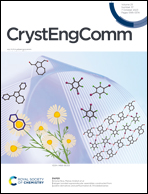Crystal structure, molecular packing, and intermolecular interactions of N-pentadecanoyltaurine and N-acyltaurine's interaction with cholesterol†
Abstract
N-Acyltaurines (NATs) are functional lipids and bioactive fatty acid amides that encompass the taurine moiety in their polar head. They are involved in various cellular and physiological roles that can lead to interesting biological properties, i.e. analgesic action, skin wound healing, regulating insulin secretion, and alteration of the cell cycle in cancer cells. Hence, it is essential to perform structural investigations at the atomic scale to comprehend their physicochemical properties and interactions with membrane lipids. Here, we report for the first time the crystal structure, molecular packing arrangement, and intermolecular interactions of N-pentadecanoyltaurine (NPDT) employing single-crystal X-ray diffraction (SCXRD) experiments; the crystal structure of NPDT is elusive as it has a triclinic space group symmetry P![[1 with combining macron]](https://www.rsc.org/images/entities/char_0031_0304.gif) within a pseudo-monoclinic lattice with lattice parameters a = 5.3204(2) Å, b = 13.5037(9) Å, c = 43.718(2) Å, α = 82.294(5)°, β = 89.769(4)° and γ = 89.830(4)°. The molecules of NPDT are arranged in a tilted bilayer fashion and conform in a head-to-head or tail-to-tail arrangement analogous to the configuration of a bilayer membrane. The sodium atoms form a distorted square pyramidal arrangement with oxygen atoms of the sulphonate groups of the NPDT molecules (Na–O distances are ∼2.3–2.4 Å) thus forming metal–organic coordination. The sodium salt of the NPDT structure is stabilized by two types of intermolecular hydrogen bonding i.e., N–H⋯O bonding between amide groups of three adjacent molecules alternated by water-assisted O–H⋯O bonding between those amides of two molecules presumably leads to the distortion of the lattice from monoclinic towards triclinic symmetry; the tilt angle obtained by the SXRD technique is ∼35–36°. Also, how NATs (NPT, and NMT) interact with cholesterol was analysed by DSC studies similar to our earlier work. The obtained data suggested that NMT and NPT mix well with cholesterol up to ∼50 mol%. These observations support the formation of an equimolar NATs : cholesterol (1 : 1) complex. Also, molecular modelling investigations validate the experimental results and give a possible structural orientation for the complex. The model showcases two H-bond interactions between the SO3H and C
within a pseudo-monoclinic lattice with lattice parameters a = 5.3204(2) Å, b = 13.5037(9) Å, c = 43.718(2) Å, α = 82.294(5)°, β = 89.769(4)° and γ = 89.830(4)°. The molecules of NPDT are arranged in a tilted bilayer fashion and conform in a head-to-head or tail-to-tail arrangement analogous to the configuration of a bilayer membrane. The sodium atoms form a distorted square pyramidal arrangement with oxygen atoms of the sulphonate groups of the NPDT molecules (Na–O distances are ∼2.3–2.4 Å) thus forming metal–organic coordination. The sodium salt of the NPDT structure is stabilized by two types of intermolecular hydrogen bonding i.e., N–H⋯O bonding between amide groups of three adjacent molecules alternated by water-assisted O–H⋯O bonding between those amides of two molecules presumably leads to the distortion of the lattice from monoclinic towards triclinic symmetry; the tilt angle obtained by the SXRD technique is ∼35–36°. Also, how NATs (NPT, and NMT) interact with cholesterol was analysed by DSC studies similar to our earlier work. The obtained data suggested that NMT and NPT mix well with cholesterol up to ∼50 mol%. These observations support the formation of an equimolar NATs : cholesterol (1 : 1) complex. Also, molecular modelling investigations validate the experimental results and give a possible structural orientation for the complex. The model showcases two H-bond interactions between the SO3H and C![[double bond, length as m-dash]](https://www.rsc.org/images/entities/char_e001.gif) O of NATs and the O–H of cholesterol, and furthermore perceptible contacts amongst the hydrocarbon regions of the two molecules.
O of NATs and the O–H of cholesterol, and furthermore perceptible contacts amongst the hydrocarbon regions of the two molecules.



 Please wait while we load your content...
Please wait while we load your content...